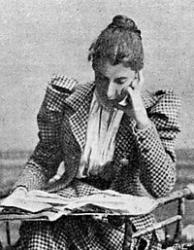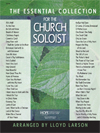- |
User Links
O perfect Love, all human thought transcending

O perfect Love, all human thought transcending
Author: Dorothy F. Gurney (1883)Tune: O PERFECT LOVE (Barnby)
Prayer Songs
Published in 238 hymnals
Printable scores: PDFPlayable presentation: Lyrics only, lyrics + musicAudio files: MIDI
Representative Text
1 O perfect Love, all human thought transcending,
lowly we kneel in prayer before thy throne,
that theirs may be the love which knows no ending,
whom thou in sacred vow dost join in one.
2 O perfect Life, be thou their full assurance
of tender charity and steadfast faith,
of patient hope and quiet, brave endurance,
with childlike trust that fears no pain or death.
3 Grant them the joy which brightens earthly sorrow;
grant them the peace which calms all earthly strife;
grant them the vision of the glorious morrow
that will reveal eternal love and life.
Psalter Hymnal, 1987
Author: Dorothy F. Gurney
 Blomfield, Dorothy F. , was born at 3 Finsbury Circus, Oct. 4, 1858. Miss Blomfield is the eldest daughter of the late Rev. F. G. Blomfield, sometime Rector of St. Andrew's Undershaft, London, and granddaughter of the late Dr. Blomfield, Bishop of London. Her very beautiful hymn for Holy Matrimony, “O perfect Love, all human thought transcending," was written for her sister's marriage in 1883, and was intended to be sung to Strength and Stay, in Hymns Ancient & Modern, No. 12. Subsequently it was set as an anthem by J. Barnby for the marriage of the Duke of Fife with the Princess Louise of Wales, on July 27, 1889. In 1889 it was included in the Supplemental Hymns to Hymns Ancient & Modern, and in 1890 in the Hymnal Companion.
--John Ju… Go to person page >
Blomfield, Dorothy F. , was born at 3 Finsbury Circus, Oct. 4, 1858. Miss Blomfield is the eldest daughter of the late Rev. F. G. Blomfield, sometime Rector of St. Andrew's Undershaft, London, and granddaughter of the late Dr. Blomfield, Bishop of London. Her very beautiful hymn for Holy Matrimony, “O perfect Love, all human thought transcending," was written for her sister's marriage in 1883, and was intended to be sung to Strength and Stay, in Hymns Ancient & Modern, No. 12. Subsequently it was set as an anthem by J. Barnby for the marriage of the Duke of Fife with the Princess Louise of Wales, on July 27, 1889. In 1889 it was included in the Supplemental Hymns to Hymns Ancient & Modern, and in 1890 in the Hymnal Companion.
--John Ju… Go to person page >Text Information
Related Texts
| First Line: | O perfect Love, all human thought transcending |
| Author: | Dorothy F. Gurney (1883) |
| Meter: | 11.10.11.10 |
| Language: | English |
| Notes: | Spanish translation: "Perfecto amor del cielo descendiendo" by Mercedes Pereda de Bernal; See "Perfecto amor que al hombre es transcendente" by George Paul Simmons |
| Copyright: | Public Domain |
| Liturgical Use: | Prayer Songs |
Chinese
English
- A Treasury of Hymns: The best-loved hymns, carols, anthems, children's hymns, and gospel songs #243
- African American Heritage Hymnal #520
- African Methodist Episcopal Church Hymnal #545
- Ambassador Hymnal: for Lutheran worship #386
- Ancient and Modern: hymns and songs for refreshing worship #348
- Anglican Hymns Old and New (Rev. and Enl.) #573a
- Anglican Hymns Old and New (Rev. and Enl.) #573b
- At Worship: a hymnal for young churchmen #72
- Australian Hymn Book #526
- Baptist Hymnal (1975 ed) #395 10 shown out of 179
Notes
Scripture References:
st. 1 = Matt. 19:4-6, Eph.3:19, 1 Cor. 13:7, 13
One Sunday evening in 1884 at Pull Wyke, Cumberland, England, Dorothy Francis Blomfield (later Gurney; b. London, England, 1858; d. Kensington, London, 1932) wrote this text for her sister's wedding. The hymn tune STRENGTH AND STAY by John B. Dykes (PHH 147) was her sister's favorite, but that hymn's text (by Ellerton and Hort) included the line "the brightness of a holy death-bed," which made it inappropriate for a wedding. So her sister challenged her to write a new text to fit that tune.
At a later time Gurney said:
After about 15 minutes I came back with the hymn, "O Perfect Love," and there and then we all sang it to the tune of "O Strength and Stay." . . . The writing of it was no effort whatever after the initial idea came to me of the two-fold aspect of a perfect union, love and life, and I have always felt that God helped me to write it.
The text was published in the 1889 Supplement to Hymns Ancient and Modern with a reference to Ruth 1:17. Because of its use at the wedding of Princess Louise and the Duke of Fife that same year, it gained much popularity. Thereafter its place in many hymnals and at many weddings was assured.
"O Perfect Love" is a prayer that Christ's love and life may infuse a wedding couple's new life together. The text, however, would be stronger if it contained a direct address to God or Christ in more customary biblical terms. In 1897, several years after her sister's wedding, Dorothy Blomfield also married. She and her husband, Gerald Gurney, were both children of Anglican clergymen. Initially an actor, Gerald was later ordained in the Church of England. But in 1919 Gerald and Dorothy joined the Roman Catholic community at Farnborough Abbey. Dorothy Gurney wrote several volumes of verse, including A Little Book of Quiet, which contained the once well-known poem "God's Garden."
Liturgical Use:
Weddings (sparingly); renewal of wedding vows in family services with a marriage renewal emphasis.
--Psalter Hymnal Handbook
Tune
O PERFECT LOVE (Barnby)Joseph Barnby (PHH 438) composed O PERFECT LOVE and said it was a "hymn tune in the natural style and idiom … of our own time." Originally an anthem, O PERFECT LOVE was shortened into a hymn tune for publication in The Hymnal Companion (1890) and in the Church Hymnary (1898). The tune is also know…
For Leaders
Text:
In 1883, Dorothy Blomfield Gurney's sister was engaged to be married. Her favorite hymn tune was John B. Dyke's STRENGTH AND STAY, but its text, St. Ambrose's “O Strength and Stay,” was a funeral hymn and therefore unsuitable for a wedding. One Sunday evening, she asked Blomfield to write a new text for the tune. Blomfield took a hymnbook into another room and wrote this hymn in about fifteen minutes. She wrote three stanzas on the theme of “the two-fold aspect of a perfect union, love and life” (Psalter Hymnal Handbook, p. 756), which were published in the Supplement to Hymns Ancient and Modern in 1889 with a reference to Ruth 1:17. A fourth doxological stanza is sometimes added, which is the third stanza of St. Ambrose's hymn, translated by John Ellerton.
Tune:
Though this hymn was first sung to John B. Dyke's tune STRENGTH AND STAY, it became popular after John Barnby wrote an anthem setting for the text for the wedding of the Duke of Fife and the Princess of Wales in 1889. He reduced the anthem to a hymn tune, which was published with the text in The Hymnal Companion in 1890. It is the tune to which this text is sung almost exclusively. It is named O PERFECT LOVE after the text; alternate names for the tune are FIFE and SANDRINGHAM.
When/Why/How:
This hymn is suitable for weddings or the renewal of vows, or services where family and marriage are a theme. The tune is popular among arrangers of organ wedding music, as seen in the arrangements in “The Organist's Library, Vol. 51” and the set of five “Variations on O PERFECT LOVE.”
Tiffany Shomsky, Hymnary.org
Timeline
Arrangements
Media
The United Methodist Hymnal #645
- MIDI file from Baptist Hymnal 1991 #512
- MIDI file from The Cyber Hymnal #5272
- MIDI file from Psalter Hymnal (Gray) #580
- MIDI file from Psalter Hymnal (Gray) #580
- Audio recording from Revival Hymns and Choruses #474a
- Audio recording from Small Church Music #104
- Audio recording from Small Church Music #104
- Audio recording from The Worshiping Church #388
- MIDI file from The United Methodist Hymnal #645
- MIDI file from Worship and Rejoice #610


 My Starred Hymns
My Starred Hymns






